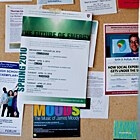News
Harvard’s School of Engineering and Applied Sciences (SEAS) is a rigorous world of applied mathematics, materials science, bioengineering, and other demanding disciplines.
But it is also a world in which nearly every common space includes green laminate signs or motion-control sensors to turn off lighting. The collective message: Be green.
Turn off the lights, wear a sweater, shut the sash on your fume hood. It’s not rocket science. Or, as they say at SEAS: It’s not quantum physics.
But simple steps like these — along with exacting building standards and other technical measures — have helped SEAS to reduce its greenhouse gas (GHG) emissions 11 percent from fiscal 2006 to fiscal 2009. That kind of progress also owes a lot to University-wide measures to save energy, said Edward P. Jackson, SEAS director of physical resources.
That number puts the School on track to meet the University’s ambitious GHG emissions goal of a 30 percent reduction by 2016, inclusive of growth, with 2006 as the baseline year.
SEAS tightened the University-wide standard for temperature set points by adjusting heating and cooling systems to start later and finish earlier. “We did it, and waited for complaints,” said SEAS manager of facilities Donald Claflin. “And there weren’t many.”
Cutting-edge science delivered direct to your inbox.
Join the Harvard SEAS mailing list.
